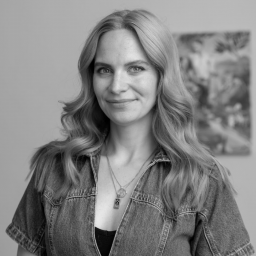Studio Visit
In His Manhattan Apartment, Edward Holland Reaches for Constellations
Edward Holland, who has dual Zodiac-themed solo exhibitions on view, gives us a tour of the Upper East Side home studio he shares with his kids.
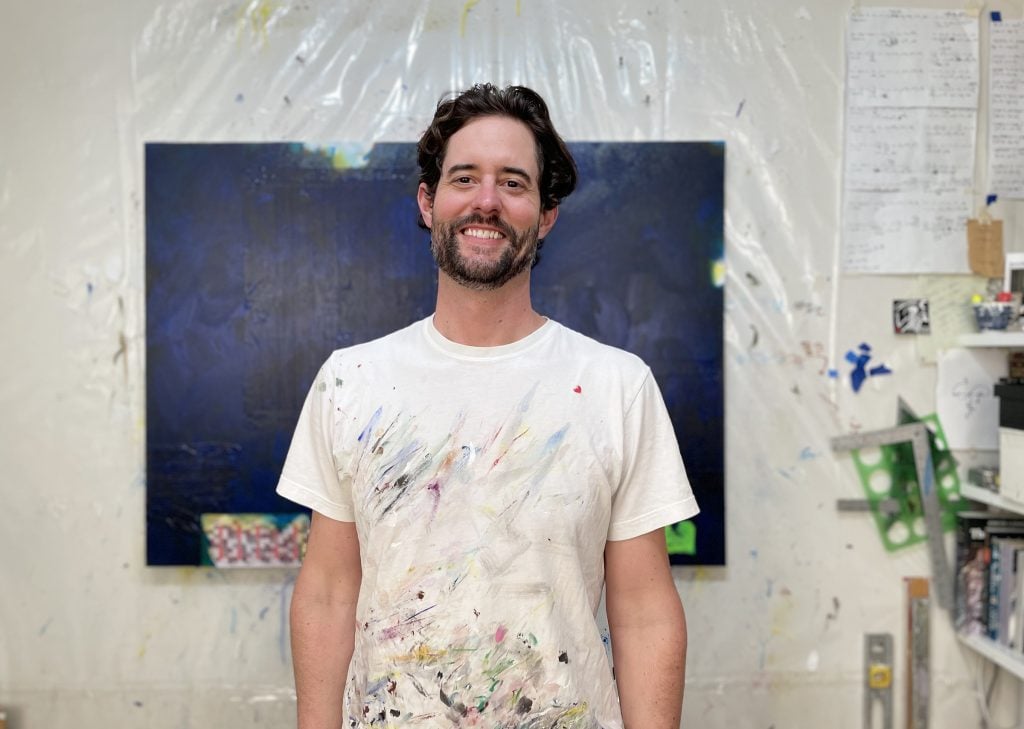
Edward Holland is a Libra which, depending on whom you talk to, may or may not be significant. The New York-based painter is best known for his zodiac painting series, which he has been working on consistently, and in accordance with the Western astrological seasons, for a decade.
In each of his canvases, he outlines the astronomical geometry of the designated constellation at a certain point in the sky, which he then uses to chart out the other formal elements of the painting. These can range from scraps of paper he found on the street, notes, poems, maps, doodles by his kids, ticket stubs, or whatever else he stumbles across. His only rule is that the material has to find its way to him organically—he won’t go out and buy anything specific. The artist, who claims he has always been a collagist, said that he even has some scraps that he has been hanging on to since elementary school, just waiting to be used when the time is right.
He then builds on this collaged foundation with paint and graphite, typically incorporating colors associated with that zodiac sign. The result is a precise but ultimately abstract record of time itself, densely layered with meaning that is both personal and universal all at once—just like a zodiac chart.
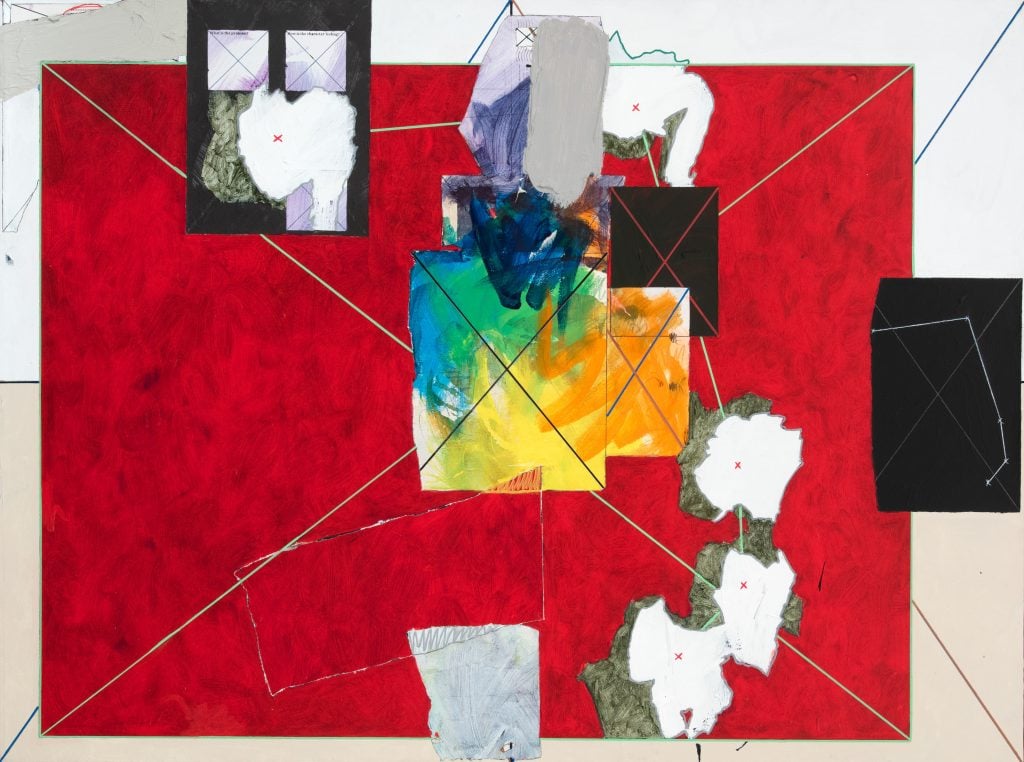
Edward Holland, The Ram (Version 19) (2023). Courtesy of Hollis Taggart.
Holland is not, however, an astrology believer… nor is he a skeptic. Instead, he says he sees it as a “great equalizer” and is more interested in the conceptual and intellectual framework the constellations offer. Moreover, he is taken with what he calls the “romance” of mythmaking and the intrinsically human desire to find meaning in the everyday as a way of ordering chaos. If one were inclined to believe in astrology, then this exceptional marriage of rational objectivity and romantic idealism might sound incredibly Libran.
Holland has two concurrent exhibitions. “At the Bottom of the Celestial Sea,” showcases his latest zodiac paintings at New York’s Hollis Taggart gallery through May 25. His first museum solo exhibition, “Edward Holland: Celestial Sea” is at the Brattleboro Museum in Vermont and runs through June 16. Holland spoke about the pros and cons of sharing a studio with his children and the trickiest astrological signs he has encountered.
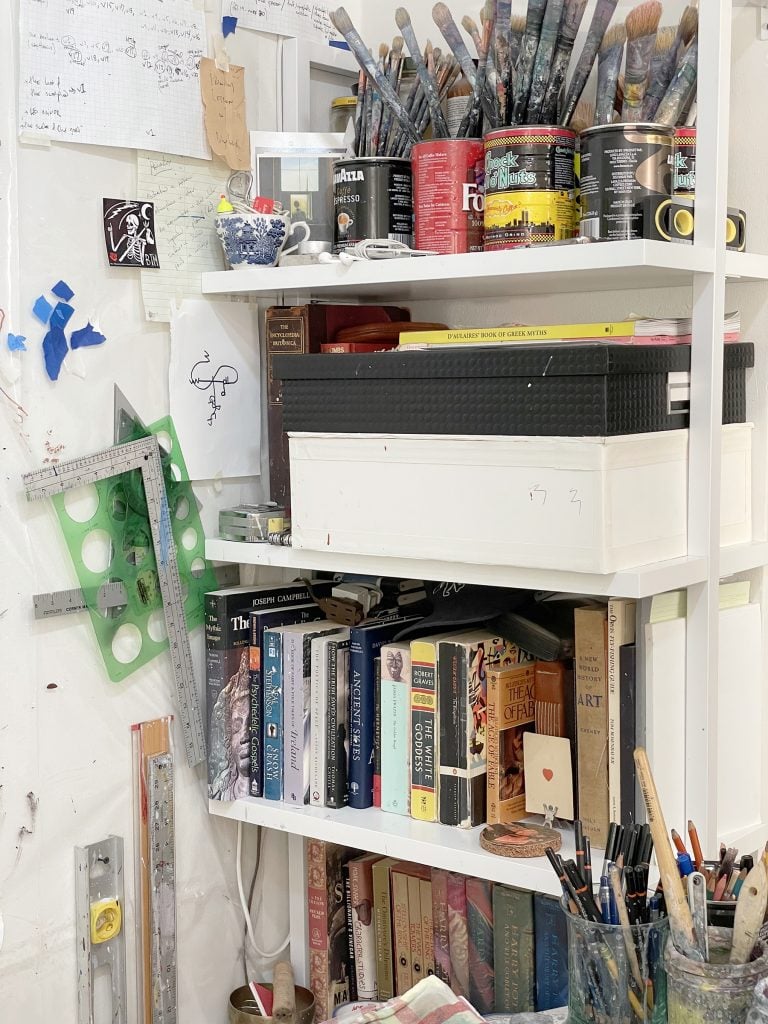
Space is sparse in Holland’s Manhattan studio, but he “makes it work.” Photo: Edward Holland.
Tell us about your studio. How does it compare to other studios you’ve had? Where is it and what kind of space is it, etc.?
My studio is tiny. It’s in my Upper East Side apartment. The only time I ever had a studio outside of my apartment was when I was in grad school. Over the years the size and location of it has shifted in my home as my needs have changed. I have two kids now and their workspaces are in the same room as my studio, so we sort of share it together. All my brushes and paints, collage elements, and reference books are on these shelves next to my desk. I have a rolling cart, which is right here underneath the desk, that’s all full of more papers and collage stuff. It’s a Spartan setup, but it’s functional. It’s not one of those big, beautiful, opulent, grand studios that people have. But maybe one day it’d be nice to have everything out in a big mess.
Do your kids like sharing the studio with you?
Yeah, I mean, honestly, they love it and want to be involved. And you know they are always asking, “Can I paint this. Can I do that?” And I feel like I’m so bad at saying yes, because it just seems like whenever they want to do that, it is a moment where I feel like the painting is on an edge, and I’m too controlling and anal about it to sort of be like, “Oh, yeah, sure. Go ahead.” So I need to be better about letting them do that. But yes, they do love it. Their friends enjoy it as well; they come over and they want to see what I’m working on— it’s like a studio visit with a 12-year-old. The setup also demystifies the art making for them, which I think is sort of good in a way. I think that whatever we can do to demystify art for people is good.

Edward Holland, The Goat (Version 19)(2023). Courtesy of Hollis Taggart.
What attracts you to collage as a medium? Do you look to any collage art historical precedents?
I like that collage is a way to deal with the language of painting without actually using paint. It’s still color, it’s still shape, it’s still texture. I think that the most historical precedent for me is actually like mid-’90’s D.C. hardcore albums, like Fugazi or a lot of the Dischord Records. Some of those albums are so beautiful, and the album covers featured a lot of collage and interesting design choices. I love them as art objects and images. Also, when I was in middle school and high school, I made zines, like everybody else at that time, and so I was always sort of combing through books and making collages. It’s just something I’ve always done.
What kind of atmosphere do you prefer when you work? Is there anything you like to listen to or watch or read while in the studio for inspiration or as ambient culture?
I always listen to music. How people can work listening to a podcast I will never understand. Maybe my musical tastes probably haven’t grown a whole hell of a lot in my life, but it’s a steady rotation of ’90s post punk and the Grateful Dead. That’s pretty much it. And then maybe some hip hop thrown in there as a palate cleanser.
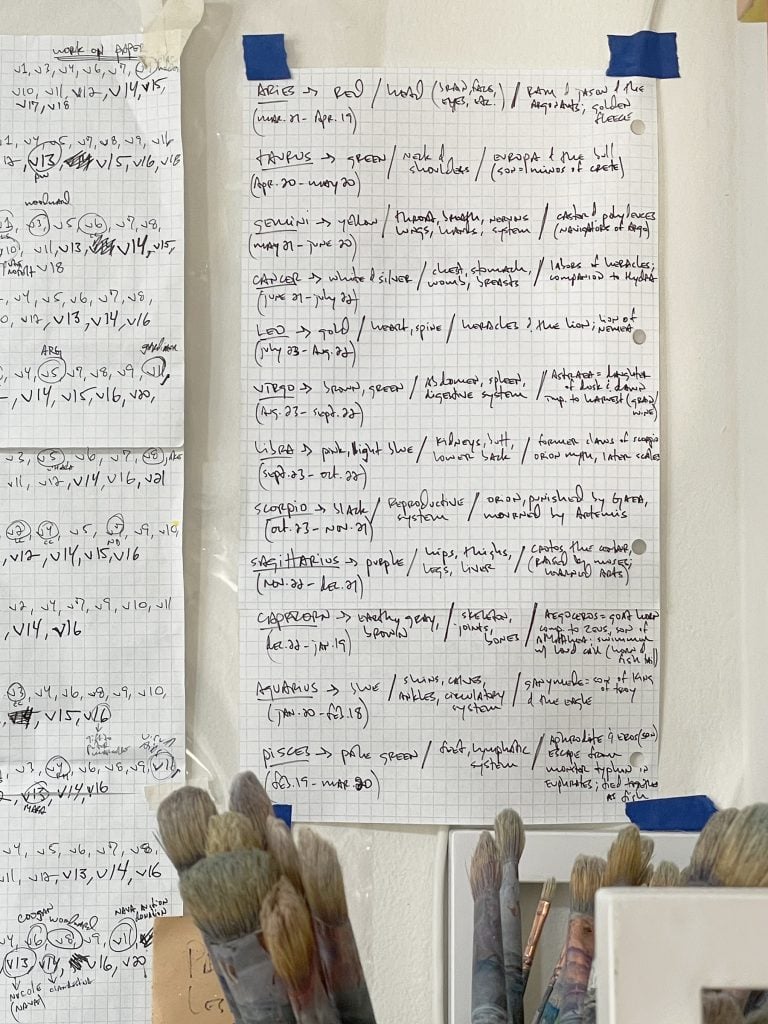
Despite the fact that he has been working on the series for 10 years, Holland said he still references his zodiac “cheat sheet” when starting a new painting. Photo: Edward Holland.
When you feel stuck while preparing for a show, what do you do to get unstuck?
I just work through. I’m jealous of artists who have like six canvases going at once and are always hopping between them, or artists that can abandon a canvas. I just keep pushing. Eventually I figure it out, and the painting gets better. I don’t know if I’m, like, happy as I push through it, but I’ll just keep working. I don’t have the luxury of time or space to just let unfinished things pile up so I just keep going. I work incrementally on one painting at a time, a few hours here or there, mostly at night —because, you know, your time is not always your own once you have kids. It takes me about 20 to 30 hours total to finish one work.
What tool or art supply do you enjoy working with the most, and why?
I don’t know if I have a favorite tool, but I will say that I think the most important thing for me in the studio is a good, comfortable pair of studio shoes. I don’t ever sit down when I work, so I’m always standing. I’ve always just worn beat-up old Birkenstocks in the studio, and they’re enough support. I can slip them on and off. They’re comfortable, and I’ve had several pairs over the years.
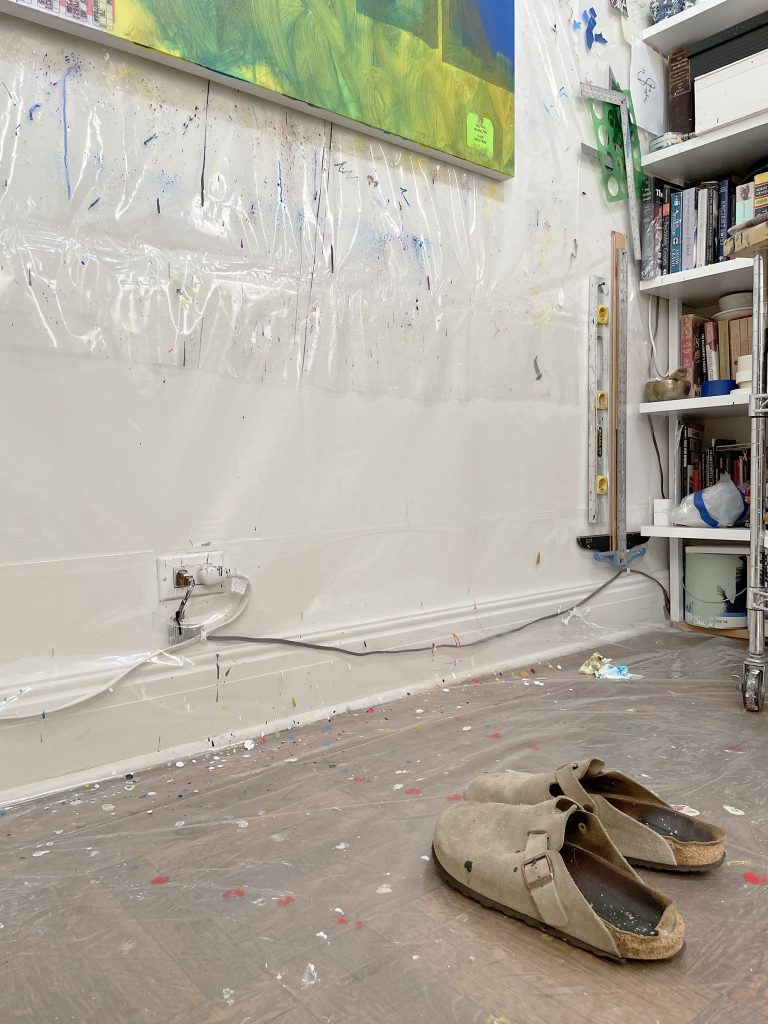
Comfortable shoes are the key to creativity, according to Holland. Photo: Edward Holland.
What got you interested in astrology?
I’ve always been a series-based painter, and I’ve always done abstractions, and the series have been kind of all over the place, but they usually grow out of a literary or art historical reference. (The Recognitions by William Gaddis and The White Goddess by Robert Graves have deeply influenced the zodiac paintings.) When I started this series, I wanted to make something that referenced mythology without being illustrative and I realized the constellations are exactly that. They’re abstract shapes but they represent a whole mythological, archetypal narrative. Every painting I do has to have the actual positions of the stars in that constellation, in the painting. Some are easier to work with than others.
What are the trickiest signs to work with based on the shape of the constellation?
Capricorn is difficult, it’s kind of a closed shape. Sagittarius and Aquarius are similarly tricky. Aries is really hard. The constellation goes straight one way and then bends just a little bit. So on a canvas, if it’s positioned vertically, it’s a fun challenge. But if you position it horizontally, you’re cutting the painting in half in this weird way. It’s a big consideration in each painting, how to deal spatially with horizontals, verticals, and squares for each sign.
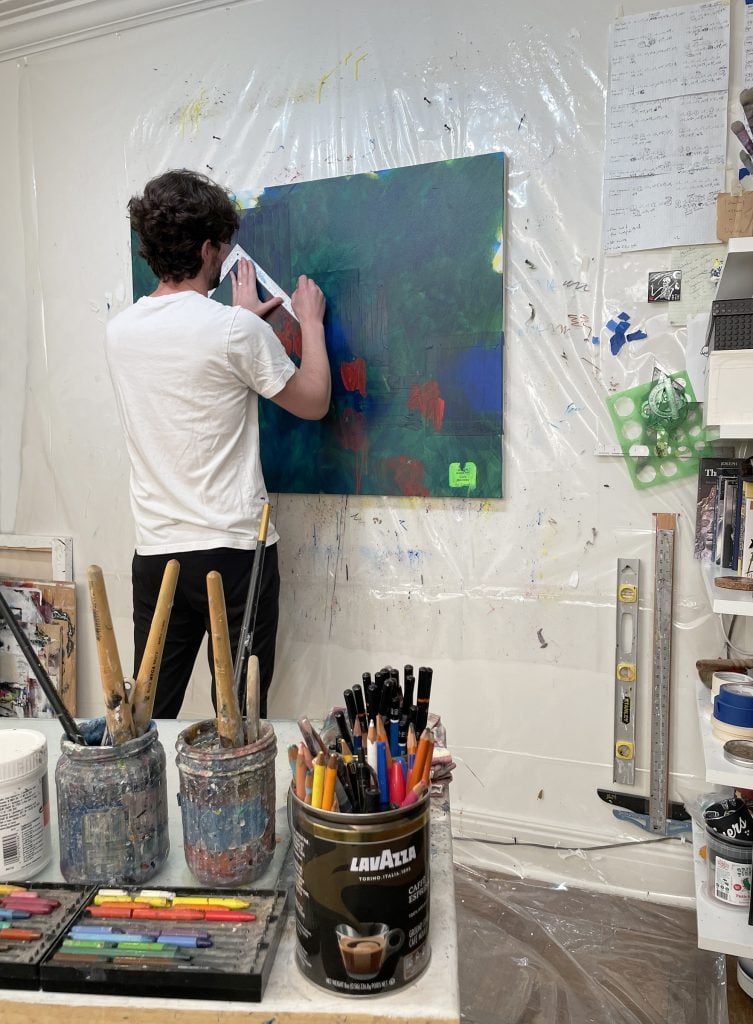
Holland at work on his latest Taurus painting. Photo: Edward Holland.
What are you working on right now?
Right now I’m working on a Taurus piece, because we’re in the sign of Taurus at this point of the year, from mid-April to mid-May. It’s a nice sign to work with. There’s lots of green in the painting, because it’s an earth sign and is associate with spring. I try to funnel as many formal decisions through the zodiac sign as possible. Here’s a bit of newspaper from 1897 that I found; it’s dated May 1, so it falls in Taurus and therefore I was saving it for a Taurus painting. Here’s part of a guide to all the different vegetables that are best in April. And Taurus rules the shoulder. The myth behind Taurus is the story of Europa and the bull, and how Zeus abducted and raped Europa, and the son of that encounter is Minos of Crete. So here I have included a reference to Minos, and also here’s part of a map of Europe for Europa. These are all little clues to help guide you forward through the painting.

